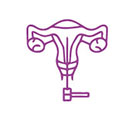HYSTEROSCOPY
Seeing is believing. Hystro means (uterus) scopy means Visualization. It is a simple day care procedure and requires no cut or suture on the body. It is done by using equipment called hysteroscope in which telescope is attached with camera and the same can be recorded for future analysis. Before embryo transfer (ET) in an IVF procedure, it is used as a diagnostic and therapeutic procedure to increase the chances of success in IVF.
Who requires Hysteroscopy?
- Abnormal uterine bleeding
- Fibroid, Polyp, cyst, septum, and adhesions if any prefound or diagnosed during hysteroscopy can be corrected in the same sitting.
- We recommend hysteroscopy for all patients before IVF as endometrial injury which is caused increases the chances of success in IVF.
- Repeated IVF failures
- Repeated miscarriage.
Steps
- Consultation and complete Evaluation of the patient followed by blood investigations and ultrasounds.
- If during ultrasound any of these lesions are found(fibroid, polyps, adhesions and septate uterus)patient is advised for Hysteroscopy (which helps to examine the uterine cavity correcting the fibroids, polyps, adhesions and septate uterus, while scratching the tissue of the lining stimulates the endometrium to increase the pregnancy rates).
- Tissue from the uterus lining is sent for histopathology examination for any disorder of the endometrium or PCR and culture to rule out genital tuberculosis.
No. of visits and Hospital Stay
It is done using short anesthesia and hospital stay is 4-6 hours.
What do we expect from you
- Clear understanding of the procedure
- Focused mind with clear aim to achieve pregnancy.
- Strong will power with happy soul.
- Harmony between mind, body and soul to alleviate stress which will go a long way in coping up with the treatment and increasing the success rates.
Risks
- Pelvic infection
- Post procedure bleeding
- Uterine perforation
There are certain factors which can create an interference with the procedure:-
- Discharge from Vagina
- Inflammation of the cervix.
- Inflamed pelvic area
It is important to discuss these with your doctor before the procedure to avoid any complication. To get more information regarding the needs and safety of the procedure, kindly visit BabySoon.
Frequently asked questions
Q1. What is hysteroscopy?
Ans:- Hystro is a Greek word that denotes (uterus) Visualization is what scopy stands for. It’s a day-care treatment that doesn’t involve any body cuts or sutures. It’s done with a device called a hysteroscope, which has a telescope attached to a camera that can be recorded for later study
Q2. What are the benefits of hysteroscopy?
Ans:- A)It increases the IVF success rate
B) Shorter hospital stay
C) Less invasive procedure
Q3. What are the risks of hysteroscopy?
Ans:- Hysteroscopy is a procedure that is quite safe. There is, however, a minor possibility of issues. The hysteroscope can puncture the uterus or cervix, causing bleeding or causing extra fluid to build up in your system.

